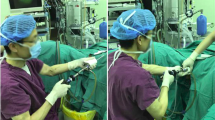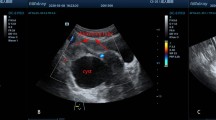Abstract
Background
Herlyn–Werner–Wunderlich syndrome is an uncommon entity characterized by uterus didelphys, obstructed hemivagina and ipsilateral renal agenesis (also called OHVIRA syndrome). Due to rarity and varied presentations, often correct diagnosis is missed out during work up, leading to management problems. We describe our dependence on detailed preoperative work up and minimally invasive endoscopic approach in management of the eight patients of OHVIRA syndrome.
Methods
In this retrospective case series study, eight patients of OHVIRA syndrome were managed from January 2012 to March 2018 with the help of improved imaging facility and diagnostic work up. Precise diagnosis helped in adopting minimally invasive approach in management. Patients were reviewed, focusing on presentation, radiologic findings and surgical management.
Results
Median age at diagnosis was 19 years (range 13–41 years). Abdominal pain and dysmenorrhea were the main presenting complaint. All patients except one had associated ipsilateral renal agenesis. Surgical excision of the obstructed hemivaginal septum and hematometra drainage was the main treatment. In seven patients, vaginoscopic resection of vaginal septum was done with resectoscope except one 41-year-old patient, where resection of vaginal septum was performed laparoscopically along with hysterectomy.
Conclusion
Vaginoscopic resection of obstructed hemivaginal septum is an effective method. Management has shifted to minimally invasive approach due to improved imaging, precise preoperative diagnosis and proper understanding of the disease.




Similar content being viewed by others
References
Schlomer B, Rodriguez E, Baskin L. Obstructed hemivagina and ipsilateral renal agenesis (OHVIRA) syndrome should be redefined as ipsilateral renal anomalies: cases of symptomatic atrophic and dysplastic kidney with ectopic ureter to obstructed hemivagina. J Pediatr Urol. 2015;11(2):77.e1–6.
Tong J, Zhu L, Lang J. Clinical characteristics of 70 patients with Herlyn–Werner–Wunderlich syndrome. Int J Gynaecol Obstet Off Organ Int Fed Gynaecol Obstet. 2013;121(2):173–5.
Ahmad Z, Goyal A, Das CJ, et al. Herlyn–Werner–Wunderlich syndrome presenting with infertility: role of MRI in diagnosis. Indian J Radiol Imaging. 2013;23(3):243–6.
Del Vescovo R, Battisti S, Di Paola V, et al. Herlyn–Werner–Wunderlich syndrome: MRI findings, radiological guide (two cases and literature review), and differential diagnosis. BMC Med Imaging. 2012;9(12):4.
Gungor Ugurlucan F, Bastu E, Gulsen G, et al. OHVIRA syndrome presenting with acute abdomen: a case report and review of the literature. Clin Imaging. 2014;38(3):357–9.
Mishra N, Ng S. Sonographic diagnosis of obstructed hemivagina and ipsilateral renal anomaly syndrome: a report of two cases. Australas J Ultrasound Med. 2014;17(4):153–8.
Haddad B, Barranger E, Paniel BJ. Blind hemivagina: long-term follow-up and reproductive performance in 42 cases. Hum Reprod Oxf Engl. 1999;14(8):1962–4.
Fedele L, Bianchi S, Agnoli B, et al. Urinary tract anomalies associated with unicornuate uterus. J Urol. 1996;155(3):847–8.
Mandava A, Prabhakar RR, Smitha S. OHVIRA syndrome (obstructed hemivagina and ipsilateral renal anomaly) with uterus didelphys, an unusual presentation. J Pediatr Adolesc Gynecol. 2012;25(2):e23–5.
Vercellini P, Daguati R, Somigliana E, et al. Asymmetric lateral distribution of obstructed hemivagina and renal agenesis in women with uterus didelphys: institutional case series and a systematic literature review. Fertil Steril. 2007;87(4):719–24.
Troiano RN, McCarthy SM. Mullerian duct anomalies: imaging and clinical issues. Radiology. 2004;233(1):19–34.
Dhar H, Razek YA, Hamdi I. Uterus didelphys with obstructed right hemivagina, ipsilateral renal agenesis and right pyocolpos: a case report. Oman Med J. 2011;26(6):447–50.
Wu W-C, Chang W-C, Yeh L-S, et al. Didelphic uterus and obstructive hemivagina with ipsilateral renal agenesis complicated by pyocolpos. J Obstet Gynecol. 2007;46(3):295–8.
Smith NA, Laufer MR. Obstructed hemivagina and ipsilateral renal anomaly (OHVIRA) syndrome: management and follow-up. Fertil Steril. 2007;87(4):918–22.
Ludwin A, Ludwin I, Bhagavath B, et al. Virginity-sparing management of blind hemivagina in obstructed hemivagina and ipsilateral renal anomaly syndrome. Fertil Steril. 2018;110(5):976–8.
Heinonen PK. Clinical implications of the didelphic uterus: long-term follow-up of 49 cases. Eur J Obstet Gynecol Reprod Biol. 2000;91(2):183–90.
[Clinical characteristics and complications in patients with OHVIRA (obstructed hemivagina and ipsilateral renal anomaly) syndrome. Our experience]. PubMed–NCBI [Internet]. [cited 2019 Mar 19]. Available from: https://www.ncbi.nlm.nih.gov/pubmed/?term=Cir+Pediatr.+2019+Jan+21%3B32(1)%3A11-16.
Author information
Authors and Affiliations
Corresponding author
Ethics declarations
Conflict of interest
The authors declare that they have no conflict of interest.
Ethical Standards
All procedures followed were in accordance with the ethical standards of the responsible committee on human experimentation (institutional and national) and with the Helsinki Declaration of 1975, as revised in 2008 (5).
Informed Consent
Informed consent was obtained from patient for being included in the study.
Additional information
Publisher's Note
Springer Nature remains neutral with regard to jurisdictional claims in published maps and institutional affiliations.
Dr. Alka kriplani, M.D. Obstetrics and Gynaecology, Consultant at Paras Hospital, Gurgaon. She was a former professor and head of department of obstetrics and gynaecology, AIIMS, New Delhi. Dr. Venus Dalal, M.D. Obstetrics and gynaecology, Consultant at Mahendru Hospital, New Delhi (former senior resident, AIIMS). Dr. Garima Kachhawa, M.D. Obstetrics and gynaecology, Associate professor at Obstetrics and Gynaecology department, AIIMS, New Delhi. Dr. Reeta Mahey, M.D. Obstetrics and Gynaecology, Associate professor at Obstetrics and gynaecology department, AIIMS, New Delhi. Dr. Vikas Yadav, M.D. Obstetrics and Gynaecology, Senior resident at Obstetrics and Gynaecology Department, AIIMS, New Delhi. Dr. Isha Kriplani, M.D. Obstetrics and Gynaecology, Senior resident at Obstetrics and Gynaecology Department, AIIMS, New Delhi.
Rights and permissions
About this article
Cite this article
Kriplani, A., Dalal, V., Kachhawa, G. et al. Minimally Invasive Endoscopic Approach for Management of OHVIRA Syndrome. J Obstet Gynecol India 69, 350–355 (2019). https://doi.org/10.1007/s13224-019-01240-4
Received:
Accepted:
Published:
Issue Date:
DOI: https://doi.org/10.1007/s13224-019-01240-4




